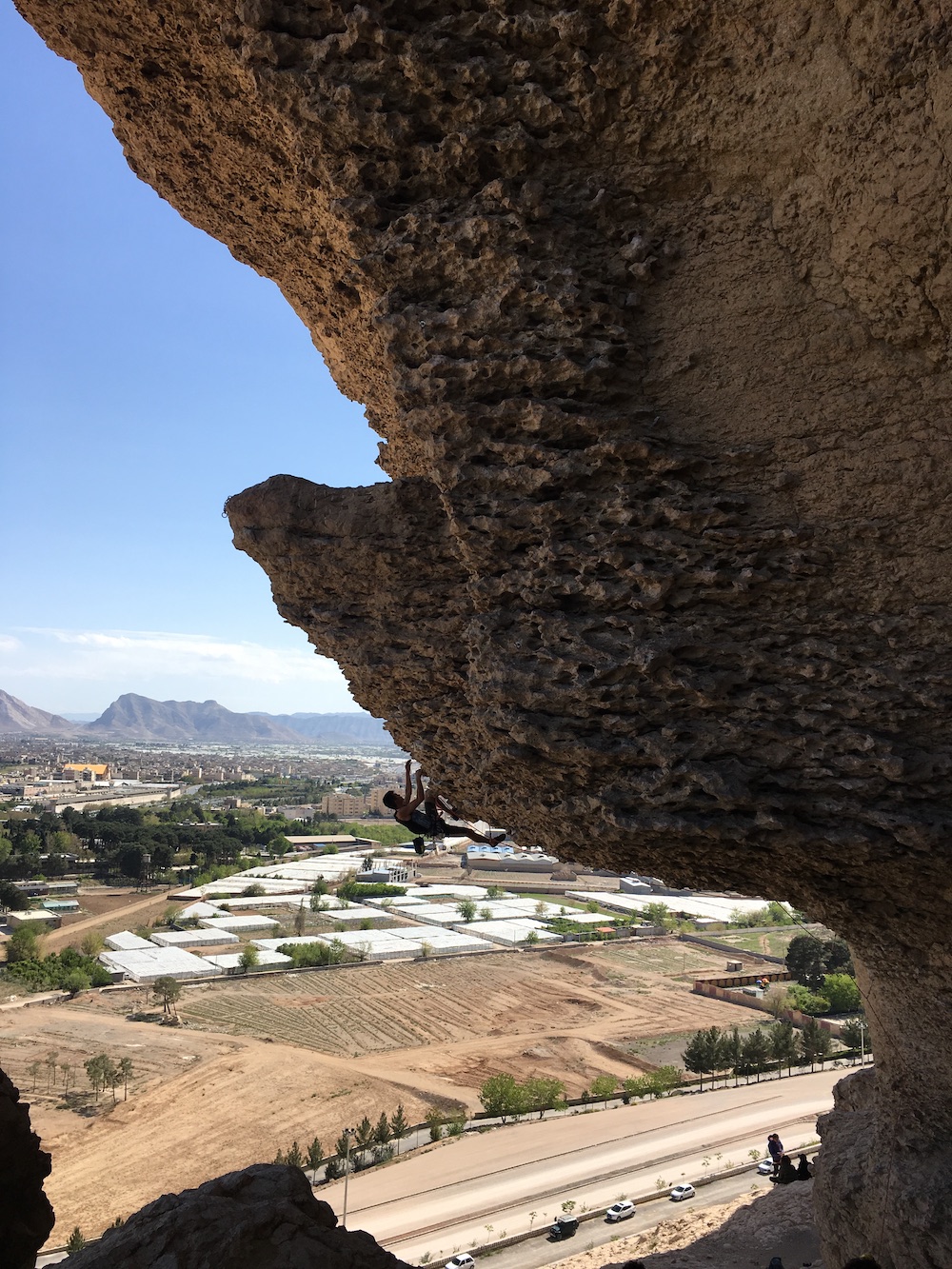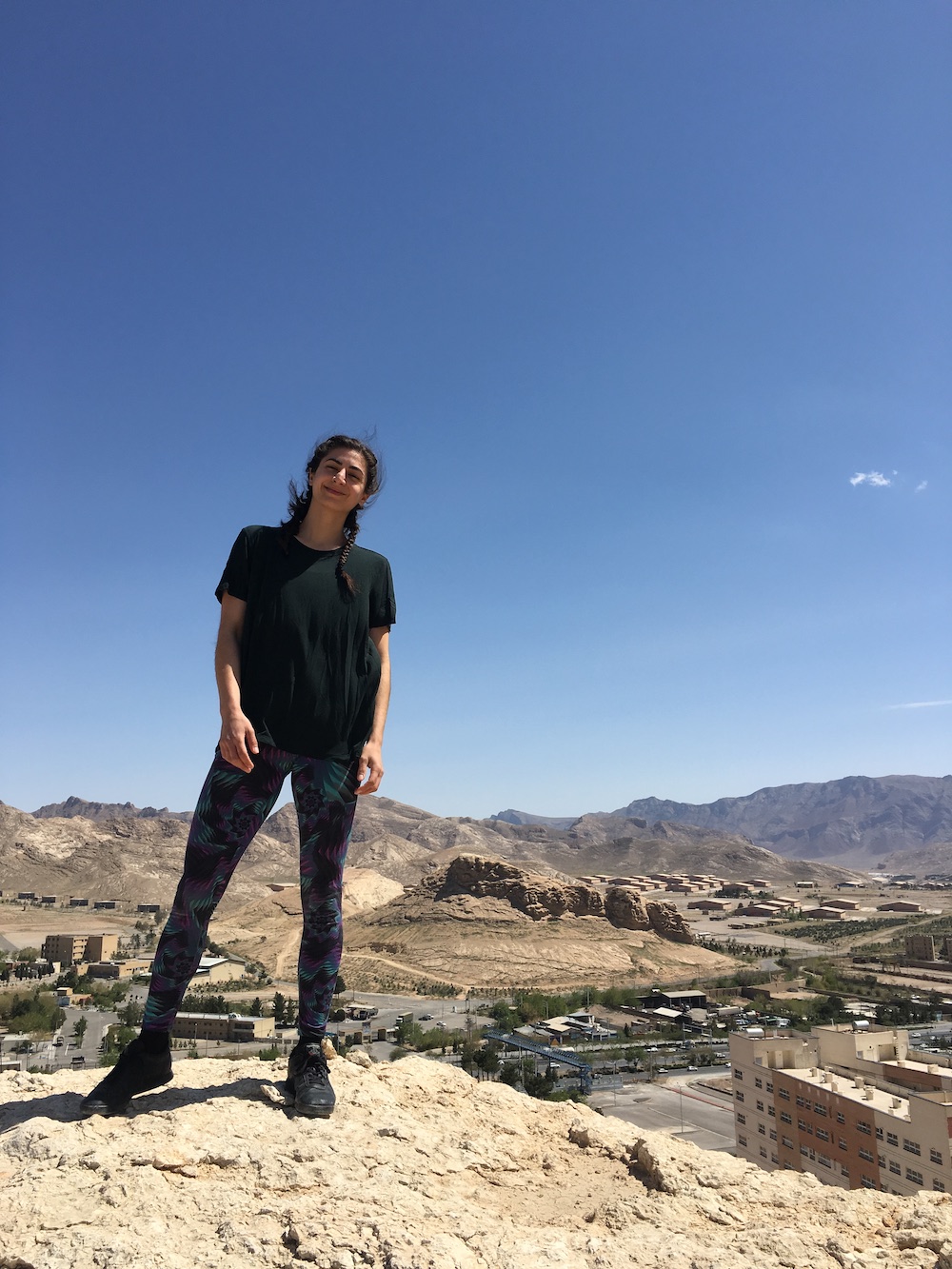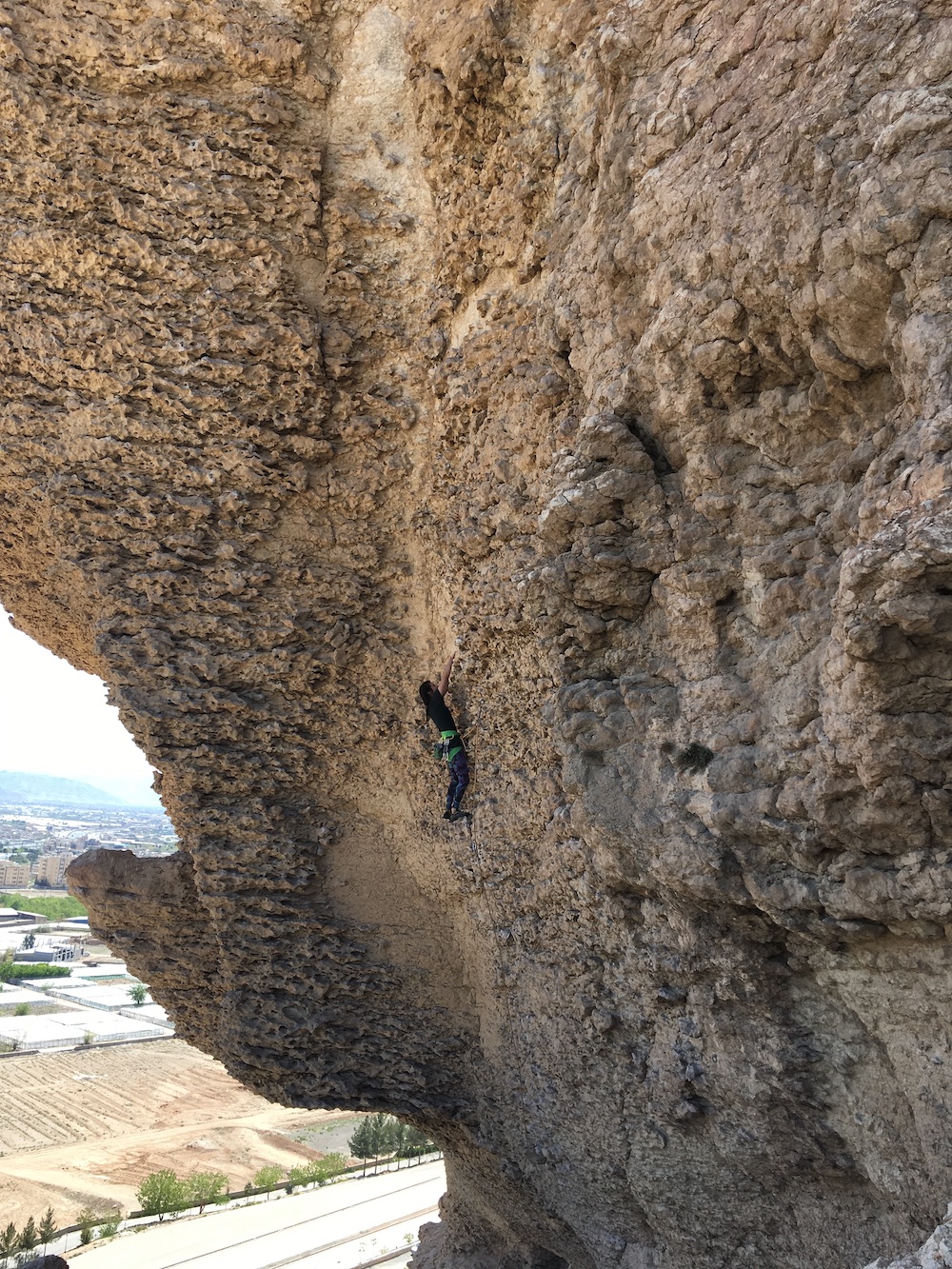I fell off the giant boulder overlooking the city. One of those that defies gravity and joins the earth at an angle, offering us a little cave when we needed shade or a place to leave our extra gear. The big boulder was my last route and it almost cost me. Lucky for me, Ali’s dad was there to catch my freefall and ease me back down to the ground. I’d attempted the climb knowing very well that our homemade mats didn’t cover nearly enough space to make it safe for us to be on this route. But if we needed to rely just on the mats, we wouldn’t have climbed a single route that day. I thanked Ali’s dad for his a-plus spotting and saw eight-year-old Ali scrambling up the other side of the rock. Our friend Hamid gave the route his best effort before we all agreed it was time for lunch. We skewered and cooked chicken over hot coals from the fire and settled in to feast before we’d have to hike down. I ripped a piece of sangak bread and used it to pull meat from the skewer, noticing my polished fingers and the last, fleeting effects of adrenaline in my system, before taking a big bite of my food. I observed the group eating around me, a mixed bag of multiple generations, my partner, and new climber friends. I felt so at ease. The next day I would be leaving Isfahan for the south of Iran and didn’t want to think about how long before I could come back.
![]()
Both of my parents immigrated to Canada in their twenties. Three siblings and myself were born to Canadian passports, a colonial education system, and English as our first language. When I was younger, I was less focused on my diasporic Iranian identity and more driven to survive a queer adolescence. From the closet, I didn’t have much room to research and deepen my bond to my ancestral lands. I know that I was lucky to grow up with the presence of much of my extended family in British Columbia. I experienced traditions I would not have otherwise known. I learned Farsi. I lived in a house filled with noise, my belly in childhood was full of Iranian food, and I had people present to pronounce our names correctly in love and in anger. My family still owns a small deli in the suburbs of Vancouver where there is a large immigrant population. I took for granted that we could cook with ingredients that were either the same or close to what would be in Iran. And yet, it took me until twenty-seven to travel to the land where my ancestors lived.
Now that I’ve been on my trip and have been home again for a time, I think I know why it took so long for me to travel to Iran. About five years ago, I started rock climbing and the sport set me on a path to being better acquainted with the outdoors and the outdoors industry. In the last few years, as a queer climber of color, my focus has shifted from climbing harder grades to being present in the movements around diversity, equity, and inclusion work. Climbing has been the vehicle to heighten my appreciation for the outdoors. And it’s introduced me to a community here that asks important questions: Who gets to access the outdoors? On whose terms? And on whose lands? When the opportunity came up to go to Iran in the spring, I knew I had to go. I wanted to get to know the landscape from the locals and see about climbing. I packed my harness and shoes and didn’t have much of an idea what would happen, I only knew it was time to go.
![]()
Iran is home to two giant mountain ranges, the Alborz and Zagros. Water to the north and south. Lush green and dry, dry desert, and some incredible ski terrain. Diverse ecosystems and a cultural history so rich and varied that I knew in my one month there I’d only skim the surface. There are cafés and youth culture; there is dismay at being a global scapegoat and living under a government that does not represent many people’s interests. There is community-centred culture and there are do-it-yourself initiatives that account for barriers to import and export. There is life without the benefits of a global superiority complex. However, the most important piece in all of this is that the initiatives, products, and ethos are by Iranians for Iranians.
I think the experience of a first-gen kid has gained some kind of stereotypical understanding from the rest of the population with more people of color coming forward with their stories. The expected narrative’s themes centre around struggle, sacrifice, hard-ass parents, and I relate to all of that. But that isn’t the whole story: beyond the sometimes strange uniformity of the “Growing Up With Immigrant Parents” story, there are endless additional narratives that shape language, purpose, sense of belonging and privilege. These are what I wanted to unwind for myself in undertaking this trip. I believe climbing over the last five years has given me an awareness not just of the land, but of myself and my positioning that was missing one last piece — my roots.

photo credit Anaheed Saatchi
I was lucky to have my friend Saba from back home in the country at the same time as me. On my third day in Tehran, she took me to Gasht Restaurant, where the hanging bulbs glowed warm light as we joined our party. They’d just wrapped a photo shoot with the owner, Houtan Karoubeh. I made my rounds, either kissing on each cheek or shaking hands, and sat beside Maryam, the entrepreneur behind Teadasun active headware. She’s a cross-disciplinary athlete and connected to the country in a way I wished to learn about. The menu is derived from Houtan’s campfire culinary innovations from his travels throughout Iran; my friends gave my partner and I recommendations of dishes and we ordered plenty of food. I asked to see Maryam’s line of headware, reminiscent of brands I knew from back home like Buff — the standard tube scarf that can be worn multiple ways. What makes Maryam’s work special are the stories and sentiments woven into the fabric. From the first piece she showed us, an illustration of the geography of Iran, to poetry by Rumi, and traditional Farsi calligraphy written across the surface, we were invited to know a captivating country. Maryam translates the packaging as she presents each of her products. My favorite would be the one she gave to me to take home, “My phoenix does not migrate with the other birds in the winter. It stays on the highest branch of the tree in the backyard, and she sings for me every morning. And as she sings, I forget all my troubles.” Shortly after, our food arrived and we shifted our attention to the feast laid out on the table. We had already touched on a major theme of the trip: having to choose to stay or to leave Iran.
A conversation that came up again and again, often in climbing contexts but with women in all varieties of spaces, explored land and roots. To leave the country and sever your roots or stay and do the work with no guarantees that one day Iran will reconcile its people and politics? I do not pretend to understand what it is like growing up in the country because I was born into a diaspora. For those with no option of leaving, there is still the blatant truth that the natural and cultural spaces of this country are combating political absolutisms. I know for a fact that there is an “awakening” in Western populations around Iran, as they realize Iranians are, in fact, some of the nicest people towards tourists. It never ceases to amaze me, the cycle of rejection, apathy, curiosity, and fake celebration that Westerners impose on the rest of the world. I am not impressed when a Westerner looks at me with the “new knowledge” that Iranians are not their government. Not that I’m any expert, after one month in the country. But I have always known that global politics and media have a calculated way of misleading us in our thoughts towards global East and West. For this reason, I will not sell Iran to a single narrative that impresses or invites tourists. I would rather make room for further discussions and invite complexity. Elaborating on the way the landscape is alive and respected by Iranian youth that appreciate their roots. The roots I am only just attuning myself towards.
![]()
Much of the climbing culture in Iran, despite the sanctions, is incredible and hard-earned. Many climbers have immense difficulty acquiring gear. As a result, they are in the process of establishing their own sporting goods equivalents: Lavan Shoes, The Cliff, Momentum Sportswear, and Teadasun to name a few. My friend and phenomenal guide, Saba, would say Iranian youth are “appropriating their own culture.” A remarkably refreshing take on a place that does not wish to be Western. Instead, they are culturally invested in a place while also being globally informed.
I’ve had the privilege to have climbed in a number of countries, and Iran is one of the most impressive places on multiple levels. As connected as Iranians are to the global zeitgeist, the mountains still offer refuge. They are historic lessons on being and can offer respite from the politics of place. Climbing is expensive, and so access is still an issue for a lot of Iranians (although cost as a barrier is thematic in climbing in Canada as well). I take what my peers have to tell me of the land, waters, and peoples as extremely valuable insights into being and belonging. Who will stay and hold down the fort?

photo credit Teresa Prado Nogueira
My partner and I connected to climbers outside of Tehran thanks to local SIM cards and social media. With messages written in Farsi and in English (Finglish), we succeeded in connecting with incredible ambassadors to the local scenes. In Isfahan, I climbed outside for the first time since being in the country. The first day we went, there was an epic wind that wrapped itself around Koo Sefid (White Mountain), a spot known to locals where the rock is some of the most impressive I’ve ever encountered. Much of what I witnessed around Isfahan used to be submerged under water; embedded in the rocks are the outlines of giant coral plants, or a hole carved into the wall that has star-shaped fossils lining the inside. I warmed up on a classic route before joining my partner to watch a woman from the national team, an Isfahan native, attempt her project: a 13b/c on the front face of the mountain. Watching someone that good on this kind of rock face makes me forget how cold the wind is. I had to try another classic route called Titanic, a beautiful roof with an immaculate array of features. For the crux bolts, I found myself almost completely inverted and loving the hanging features and tricky footwork. The same woman from the hard route hopped on the route after me and did it as her cooldown in her runners. Our friend guided us up to the peak of the mountain and we sat down to a lunch of salad olivieh (Persian potato salad), and fresh bread. Over the course of the meal, and with a panoramic view of the city, I listened to my Isfahani friend talk about his goals of going the non-traditional route (marriage and kids) and instead form his own climbing enterprise. He is a coach, a competitive climber for the country and he is 20 years old. He told me he made his own crash pads that we would use the next day to go bouldering. But he still had a degree of sadness around the state of Iran. And he holds onto the hope that things will change with time. I thought about this sadness a lot in my time there, that the outdoors is something so incredible that it can hold space for youth trying to stay connected to the country instead of leaving. My family on my mother’s side is largely Isfahani, so being on that mountain felt somewhat surreal.
The other city we visited, Shiraz, is home to an impressive climbing scene as well as the best gym I’ve ever been to. We met with one of the top female climbers in the city and, continuing the string of Iranian hospitality, she saw to it that we had time to connect and get to know the area. We learned that, for her community, much of the climbing scene was self-directed. Despite sanctions on importing gear and government policies on propriety, these individuals insist on connecting to the outdoors and the outdoors industry in ways that empower them. She put us on some boulder problems that had me on my ass more times than I care to admit. This was not the first time that I felt an ease and confidence while in a gym space without bros beta spraying me. In Tehran, the gym time was women-only and there’s definitely something to be said for the power of affinity spaces. When we went outside, we were a group of five people at a bouldering spot right up in the hills around the city. The fresh breeze and late-afternoon sun were calming and it was impossible not to feel uplifted by the scene in front of me. Climbing in community, anywhere in the world, has constantly renewed my faith in the sport. Even amidst how straight, white, male-centric the industry is.

photo credit Teresa Prado Nogueira
![]()
As I write this, I remember Maryam. The way she turned over a piece of fabric and told me how she, too, has family in Toronto, and each day she asks herself stay or go? Yet, she always comes back to the land. Her roots. A relationship that had always felt unattainable for me. Even as someone who grew up surrounded by nature, I have learned not to own any entitlement to those lands. I am a queer, first-generation womxn, a settler, and I don’t know what it means to grow up on the land where my ancestors are buried. Even when I finally made the trip to Iran, I felt “other,” and I am learning to accept that my role is likely a bridge between worlds. In Canada, I am climbing on the unceded lands of the Musqueam, Tsleil-waututh, and Squamish Nations and have been a visitor on many other lands. When it comes to the Outdoors, I want to know how best to care for the land and access it with community in mind. My Iranian peers are gatekeepers to knowledge I have been craving since I was a child. They have begun to satisfy a hunger I didn’t know I had. My belonging is grounded in these connections to people as well as place. Meeting with Maryam and being guided by my friend Saba leads me to consider my diasporic and queer identities. Now that I’ve been to Iran, I know that I feel rooted there and celebrate a new sense of place. But most importantly, I’ve learned that in accessing the outdoors we can break stereotypes and build communities that endure.🌲
edited by rachel.


Wow! This is a great, evocative, complex piece. Thanks for sharing it with us.
(And thanks to REÍ for sponsoring the whole issue!)
Wonderful story!
As a queer first gen climber myself can I just say I really really enjoyed this piece. The sport can be so white and male but it has meant so much to me in the year that I’ve started. It’s refreshing to see another queer WOC talk about it. It’s so true that the sport is inaccessible I was using rental gear for months until I could actually afford stuff that was significantly on sale during the holiday season. Not to mention the costs of outdoor climbing gear and travel!
That’s so cool that you got to explore the climbing scene in Iran as someone with a connection to the country. I LOVE that even though they face boundaries the Iranian climbers make do and kick ass. I wonder if they will compete in the upcoming Olympics?
This was a great read, thank you for writing it and sharing your story!
Uau Anaheed, what an amazing piece! I’m so glad I got witness this article evolving during the last days of our trip – bringing all these memories together, celebrating the people we met and places we visited. What a privilege to have traveled to Iran with you!
I loved this! Thanks for sharing.